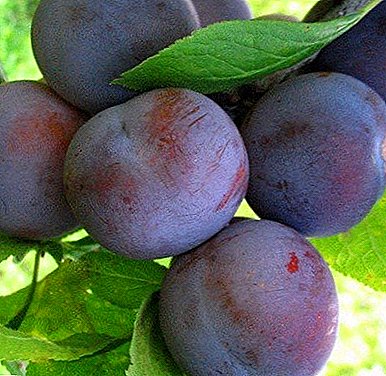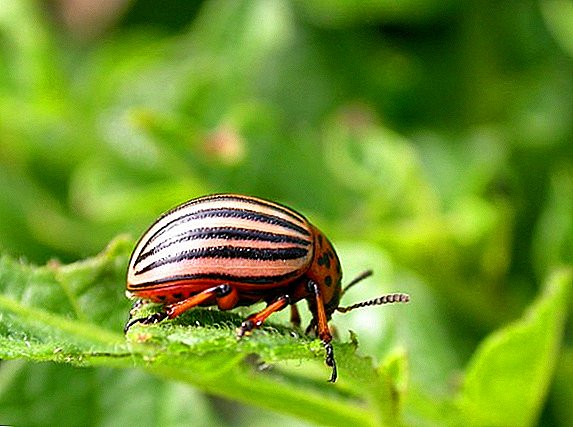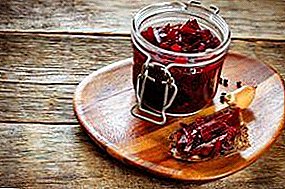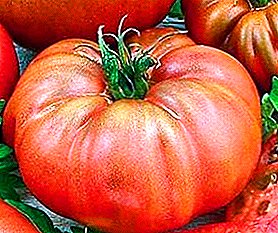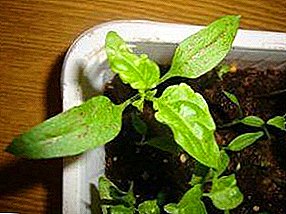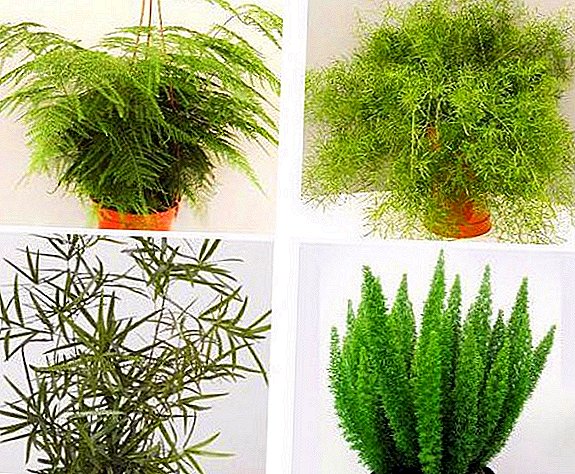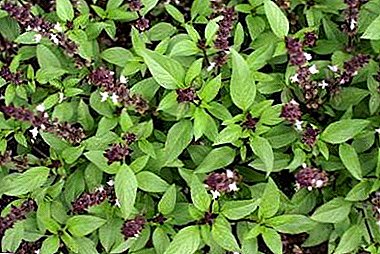
Basil is a spicy herb that has been used successfully in cooking. Is it possible to plant seeds in open field?
Basil comes from warm edges, so growing spicy grass on open ground in some regions of Russia is difficult, but quite possible. The main thing is to know the rules and conditions for growing.
From this article you will learn about which varieties of basil are suitable for cultivation in the open field, how to choose the right seeds, buy them and prepare them for planting in the spring.
The best varieties for growing
Basil has many varieties and varieties, but not all of them are suitable for growing in open ground. For medium and northern regions of Russia, it is recommended to select cold-resistant, early, mid-early or mid-season varieties. Most Russian gardeners liked the following varieties.
"Clove"
It grows up to 60 cm. Bush dense, with large green leaves. It has a distinctive aroma and taste.

"Caramel"
Early and high-yielding variety. The leaves are large, juicy, have a pleasant smell of caramel and fruit.

"Table"
Tall variety. The leaves are large, juicy, green, have a mild flavor and pronounced aroma.

"Cinnamon"
Srednerosly bushes, leaves green with purple veins. It has a touch of cinnamon.

"Philosopher"
Early, medium grade. The leaves are large, wavy, purple. It has a strong aroma with a taste of cloves.

"Anisic"
Shrubs semi-sprawling, sredneroslye. Stem branched, juicy leaves, with a pronounced aroma of anise.

"Citric"
Bushes are low, the foliage is pale green. The plant has a refreshing lemon flavor and aroma..

How to choose and arrange a place?
In order to get a rich harvest of basil, the soil must pick a nutritious, rich in organic matter. Basil grows best after vegetable crops that have been fertilized with manure, peat or humus - eggplants, cucumbers, peppers, etc. Also suitable soil after tomatoes and legumes.
The bed is better to have in a sunny place, covered from the wind. Light, breathable and with neutral acidity is considered the best soil.. If the soil is clay, it is recommended to dilute it with sand, if acidic - with lime.
reference: in order to avoid fusarium, it is not recommended to plant basil on the same place for several years in a row.
How to prepare the soil?
- It is recommended to prepare the soil in advance, in the fall: it is good to dig, fertilize, remove weeds. Composting or manure is enough to feed the soil, about half a bucket per square meter.
- To increase the yield, you can apply mineral fertilizers, but it is desirable to make them in the spring, just before planting. Potash and nitrogen fertilizers are enough for 15-20 g / m², superphosphate 30-40 g / m².
- Wood ash is no less useful - it serves as both fertilizer and protection from most pests; you need to make it at least 500 g / m² (about a liter jar).
- In the spring, you can once again dig and fertilize the soil.
Planting seeds
Basil allows the cultivation of both directly into the soil, and the method of seedlings. Most experienced gardeners prefer planting seedlings, as this method is more reliable.
Can I immediately sow?
To determine the method of planting seeds of basil it is necessary to rely on the local climate and the desired time of first harvest. In the northern regions is not recommended planting seeds immediately in open ground, as at the end of the summer there is already a significant decrease in air and soil temperature. In this case, you can simply not have time to harvest. Seedlings planting method is favorable for any heat-loving plants, and in most Russian regions it is extremely desirable.
When to carry out the procedure in the spring?
When to plant basil seeds and seedlings? Planting seeds in open ground is carried out in the spring, after the night cooling periods are gone and warm weather has steadily established. Basil is actively growing at a temperature of at least 20 ° C, usually this temperature is set in late May or early June. The timing of planting on seedlings begins in early April and usually lasts until the middle of the month.
How to choose seeds, what does the healthy material look like in the photo?
Healthy basil seeds are small, black, shaped like sesame seeds. They are covered with a hygroscopic thin film shell, therefore if the seeds are poured with water, the shell will swell and the seeds will look like eggs.
Before planting seeds, it is advisable to check for suitability.
- In a full glass of water, add 1 tsp. salt, mix until dissolved, then pour the seeds.
- Wait 3 minutes, remove the surfaced seeds - they are not suitable.
- Remove the rest, rinse and dry first with a paper towel, then in the open air in a cool shady place.



Where to buy and what to look for when buying?
Basil seeds can be purchased in specialized agro shops, as well as in ordinary supermarkets or via the Internet. The main thing, it is necessary to pay attention to the expiration dates of seeds - at the basilica it is no more than a year. The fresher the seeds, the greater the percentage of similarity of seedlings. The price of basil seeds for a package of 0.3-0.5 g in Moscow is 9-32 rubles, in St. Petersburg - 2-29 rubles.
How to prepare?
- Before sowing in the spring, purchased seeds are recommended to hold 2 weeks in a warm place, preferably at the battery. This will increase the similarity of basil.
- Immediately before planting, the seeds are disinfected in a concentrated manganese solution for 2 hours.
- For faster germination, seeds can be soaked in a solution with Zircon growth stimulator.
How to plant?
How best to plant basil from seeds, for example, in the country?
- For planting seeds in open ground prepare small trenches with a depth of 1-2 cm. The earth must be moistened.
- Seeds are covered with earth and trampled.
- If the soil is wet, watering the planted seeds is not necessary.
- The top growth point of the plant is pinched; it is possible with a pair of leaves - it will allow basil to grow in breadth, not up.
- Stretched or overgrown seedlings can be deepened to cotyledon leaves.
Scheme: at what distance to place the plants among themselves in the beds?
How to plant basil seeds? Basil seeds are planted in rows at a distance of 35-40 cm from each other. Is it possible to deepen the seeds when planting? Seeds are sown individually, at a distance of 2-3 cm from each other, to a depth of 1-1.5 cm.
In a mixed garden with tomatoes, basil is recommended to be planted between the bushes of tomatoes and at a distance of 40-50 cm between the bushes of basil. Among the potatoes and eggplant, basil can be planted a little more often - 30-40 cm
How to sow, to quickly ascended?
Basil can grow very strongly, so planting in rows suggests a desired distance of 30 cm. You can spread 2 seeds in a row with a distance of 5-6 cm.
If all the seeds sprout, more sluggish sprouts can be removed.. To the seeds quickly ascended, the bed is covered with a film, and after germination it is removed.
How to care?
 Until the plant grows stronger and begins to grow vigorously upwards, regular weeding from the weeds is necessary.
Until the plant grows stronger and begins to grow vigorously upwards, regular weeding from the weeds is necessary.
In about a couple of weeks, shoots should appear that need to be thinned periodically (as soon as the plant can be grasped at the top). During the first thinning, the plants are left at a distance of 10 cm, with the second already 20-30. Further care of the bushes is carried out as when planting seedlings.
It is important to monitor the soil moisture - it should not dry out or be too wet. Increased soil moisture threatens young plants with a black leg. If it suddenly appeared, the plants should be urgently treated with a solution of copper sulphate - 1 tsp / 2 l of water. Basil should be watered moderately after the topsoil has dried.
Watered with warm water, about 25 ° C, preferably infused during the day. Periodically, it will be necessary to loosen the soil surface before irrigation, approximately 8 times per season. For better branching, it is desirable to gently break down the flower stalks that have appeared.
- To stimulate the active growth of greenery, basil should be regularly fed, about once every 28 days. The first feeding with the Nitrophoska solution is carried out 2 weeks after planting in open ground. About 3-4 tablespoons of Nitrophoska are taken per 2 liters of water; per 1 m² of land requires about 3-4 liters of mortar.
Growing basil is quite simple both at home and in the open field. The plant does not require excessive care, and when planted on mixed beds, basil can protect other cultivated plants from pests such as ants and the Colorado potato beetle.


